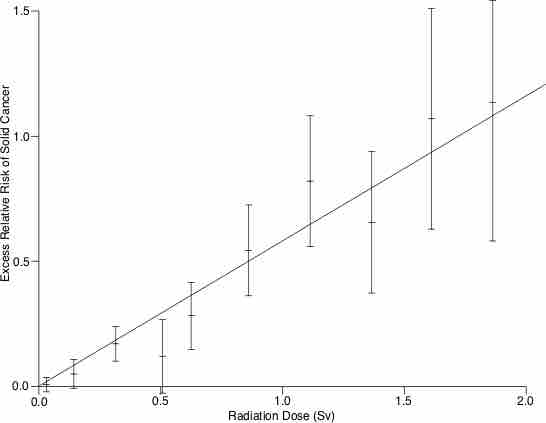Up to 10 percent of invasive cancers are related to radiation exposure, including both ionizing radiation and non-ionizing radiation. Additionally, the vast majority of non-invasive cancers are non-melanoma skin cancers caused by non-ionizing ultraviolet radiation.
Exposure to ionizing radiation is known to increase the future incidence of cancer, particularly leukemia. This association is based largely on studies of Japanese atomic bomb survivors. The relationship between cancer risk and radiation dose for that group was shown to be directly proportional.

Cancer risk by radiation dose
An increased risk of cancer has been shown to correlate with radiation dose. One example of this connection is shown here for Japanese survivors of the atomic bomb.
The mechanism by which this occurs is well understood, but quantitative models that aim to predict the level of risk remain controversial. The most widely accepted model posits that the incidence of cancer due to ionizing radiation increases linearly with effective radiation dose at a rate of 5.5 percent per sievert. If the linear model is correct, natural background radiation is the most hazardous source of radiation to the general public health, followed closely by medical imaging. Cancer is a stochastic effect of radiation, meaning that the probability of occurrence increases with effective radiation dose, but the severity of the cancer is independent of dose.
Cancer starts with a single cell whose operation is disrupted. Direct and indirect damage eventually impact chromosomes and epigenetic factors that control the gene expression. Cellular mechanisms will repair some of this damage, but some of these repairs will be incorrect, and chromosomal abnormalities will turn out to be irreversible. The development of cancer can be divided into three major stages: morphological changes to the cell, acquisition of cellular immortality, and adaptations that favor tumor formation.
Decades may elapse between radiation exposure and detection of cancer.